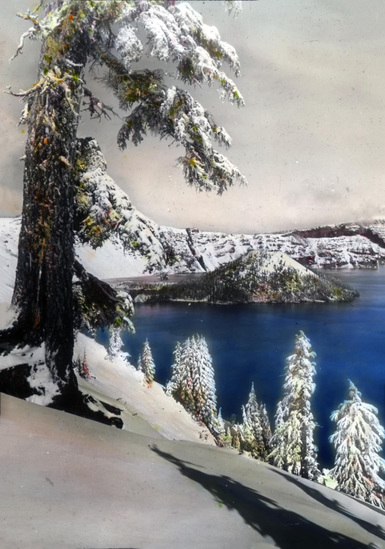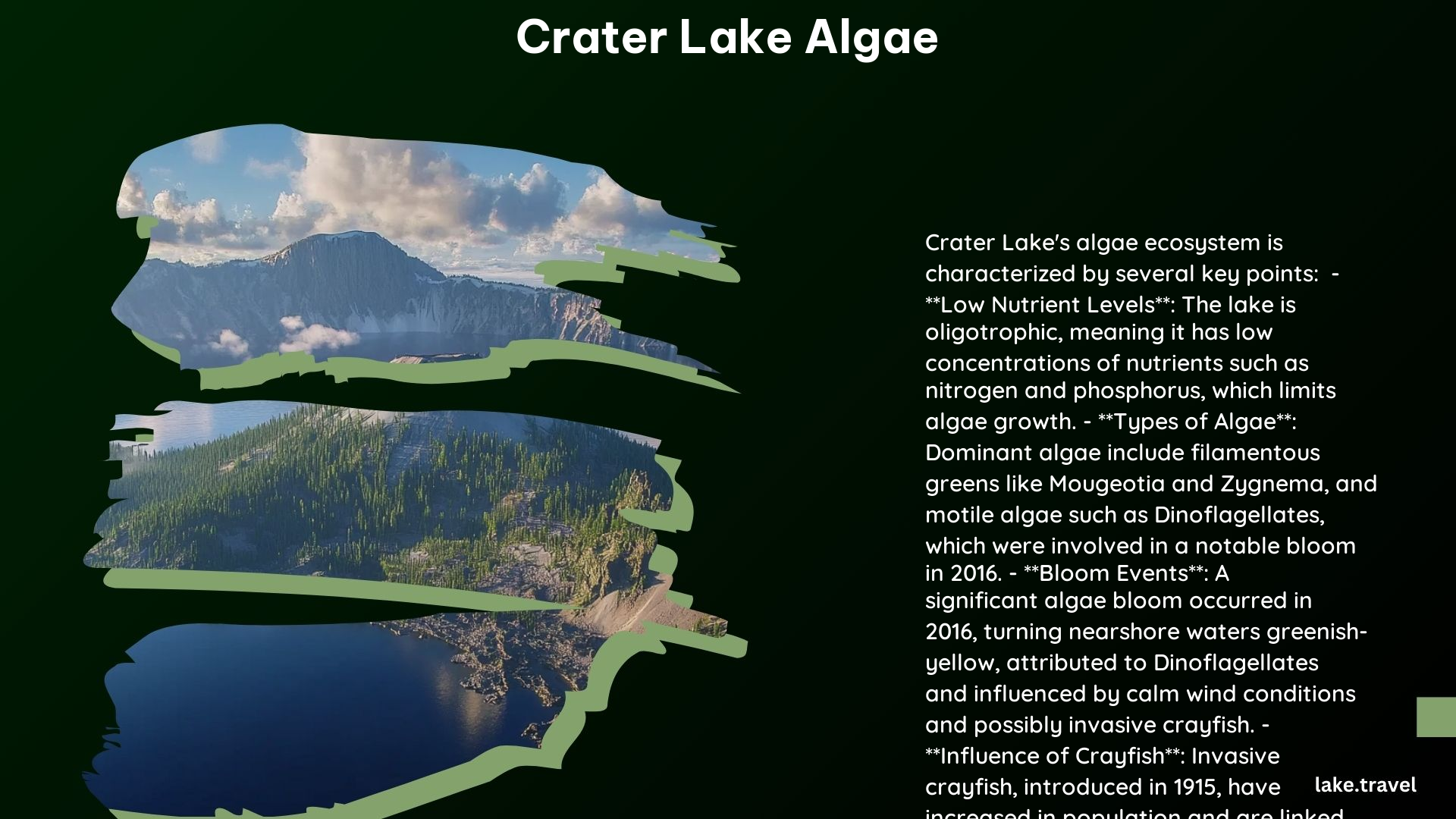Crater Lake, renowned for its exceptional clarity and oligotrophic nature, harbors a distinctive algae ecosystem. Despite its nutrient-poor environment, the lake supports a limited variety of algae species, primarily diatoms and filamentous algae. These organisms play a crucial role in the lake’s delicate ecological balance, interacting with aquatic moss and microbial communities. Understanding the algae in Crater Lake is essential for preserving its pristine condition and monitoring potential changes due to environmental factors.
What Species of Algae Are Present in Crater Lake?

Crater Lake’s oligotrophic environment limits the diversity of algae species, but several types have adapted to thrive in these nutrient-poor waters:
- Diatoms: These microscopic algae are the most prevalent in Crater Lake. Some common species include:
- Cyclotella sp.
- Fragilaria sp.
-
Asterionella formosa
-
Filamentous algae: These form thread-like structures and are often found in association with aquatic moss. Examples include:
- Mougeotia sp.
-
Spirogyra sp.
-
Cyanobacteria: While not true algae, these photosynthetic bacteria are often grouped with algae and play a crucial role in the lake’s ecosystem:
- Nostoc sp.
- Calothrix sp.
It’s important to note that the algal community in Crater Lake is dynamic and can vary seasonally and with depth.
How Do Algae Interact with Other Organisms in Crater Lake?

The algae in Crater Lake form an intricate web of relationships with other organisms:
- Aquatic Moss Interaction:
- Algae, particularly filamentous types, often grow in association with the aquatic moss Drepanocladus aduncus.
-
This moss provides a substrate for algae growth and harbors nitrogen-fixing cyanobacteria.
-
Microbial Mat Formation:
- Algae contribute to the formation of microbial mats on the lake bottom.
-
These mats are complex communities of microorganisms that play a role in nutrient cycling.
- Algae serve as a primary food source for zooplankton and other small aquatic organisms.
- This forms the base of the lake’s food web, supporting fish and other higher-level consumers.
What Factors Influence Algae Growth in Crater Lake?
Several factors contribute to the growth and distribution of algae in Crater Lake:
- Nutrient Availability:
- The lake’s low nutrient levels, particularly nitrogen and phosphorus, limit algal growth.
-
Any increase in nutrients could potentially lead to increased algae populations.
-
Light Penetration:
- The exceptional clarity of Crater Lake allows light to penetrate to great depths.
-
This enables photosynthesis to occur at deeper levels than in most lakes.
-
Temperature and Stratification:
- The lake’s thermal stratification affects nutrient distribution and algal growth patterns.
-
Climate change could potentially alter these patterns in the future.
-
Water Chemistry:
- The lake’s slightly alkaline pH and low mineral content influence which algae species can thrive.
How Do Algae Blooms Affect Crater Lake’s Water Quality?
Algae blooms in Crater Lake are rare due to its oligotrophic nature. However, if they were to occur, the potential impacts could include:
- Reduced Water Clarity:
-
Excessive algae growth could decrease the lake’s famous clarity.
-
Oxygen Depletion:
-
As algae die and decompose, they consume oxygen, potentially leading to hypoxic conditions in deeper waters.
-
Nutrient Cycling Changes:
-
Algae blooms could alter the lake’s delicate nutrient balance.
-
Aesthetic Impact:
- Visible algae growth could affect the lake’s pristine appearance.
It’s important to note that these impacts are largely hypothetical for Crater Lake, as significant algae blooms are not currently a problem.
What Monitoring Practices Are in Place for Crater Lake Algae?
The National Park Service and U.S. Geological Survey conduct regular monitoring of Crater Lake’s ecosystem, including its algae populations:
- Water Sampling:
-
Regular collection of water samples at various depths to analyze nutrient levels and algae presence.
-
Secchi Disk Measurements:
-
Used to monitor water clarity, which can be affected by algae concentrations.
-
Genetic Sequencing:
-
Advanced techniques to study the microbial communities, including algae species.
-
Long-term Ecological Research:
-
Ongoing studies to track changes in the lake’s ecosystem over time.
-
Remote Sensing:
- Satellite imagery analysis to detect any large-scale changes in water color or clarity.
How Might Climate Change Impact Crater Lake’s Algae Ecosystem?
Climate change poses potential risks to Crater Lake’s delicate algae ecosystem:
- Altered Mixing Patterns:
-
Warmer temperatures could change the lake’s mixing cycles, affecting nutrient distribution.
-
Extended Growing Seasons:
-
Longer ice-free periods could lead to extended algae growing seasons.
-
Increased Nutrient Inputs:
-
Changes in precipitation patterns could alter nutrient runoff into the lake.
-
Species Composition Shifts:
-
Warming waters might favor different algae species, potentially altering the ecosystem balance.
-
Increased Stratification:
- Stronger thermal stratification could impact nutrient cycling and algae distribution.
| Climate Change Factor | Potential Impact on Algae |
|---|---|
| Warmer Temperatures | Extended growing seasons, altered species composition |
| Changed Precipitation | Increased nutrient inputs from runoff |
| Altered Mixing Cycles | Changes in nutrient distribution and availability |
| Stronger Stratification | Impacts on vertical distribution of algae and nutrients |
What Role Do Algae Play in Crater Lake’s Nutrient Cycling?
Algae are crucial components of Crater Lake’s nutrient cycling process:
- Primary Production:
-
Algae convert inorganic compounds into organic matter through photosynthesis.
-
Nutrient Uptake:
-
They absorb dissolved nutrients from the water, incorporating them into their biomass.
-
Nutrient Release:
-
As algae die and decompose, they release nutrients back into the water.
-
Support for Higher Trophic Levels:
-
Algae transfer energy and nutrients up the food chain as they are consumed by other organisms.
-
Interaction with Microbial Communities:
- Algae work in concert with bacteria and other microorganisms in nutrient transformation processes.
Understanding these processes is crucial for maintaining the lake’s ecological balance and pristine condition.
How Do Researchers Study Algae in Crater Lake?
Researchers employ various techniques to study algae in Crater Lake:
- Water Column Sampling:
-
Collection of water samples at different depths to analyze algae populations.
-
Microscopy:
-
Examination of algae specimens to identify species and assess population densities.
-
Chlorophyll Analysis:
-
Measurement of chlorophyll concentrations as an indicator of algal biomass.
-
Genetic Sequencing:
-
DNA analysis to identify algae species and study community composition.
-
Biogeochemical Measurements:
-
Analysis of nutrient concentrations and other chemical parameters that influence algae growth.
-
Long-term Monitoring:
-
Continuous data collection to track changes in algae populations over time.
-
Remote Sensing:
- Use of satellite imagery to detect large-scale patterns in water color and clarity.
These diverse research methods provide a comprehensive understanding of Crater Lake’s unique algae ecosystem and help inform conservation efforts.
References:
1. Models examine how climate change may affect Oregon’s Crater Lake
2. Researching the Riddle of Crater Lake’s Secret Garden
3. Unexpected diversity found within benthic microbial mats … – Frontiers
